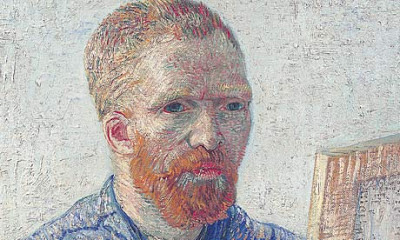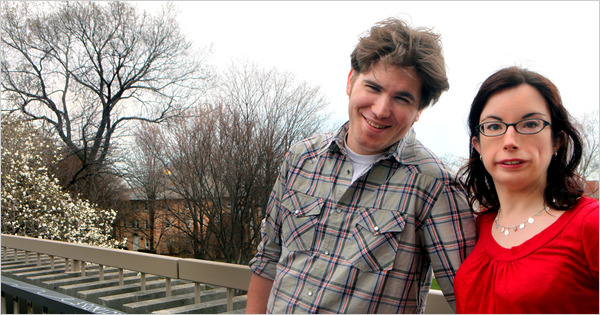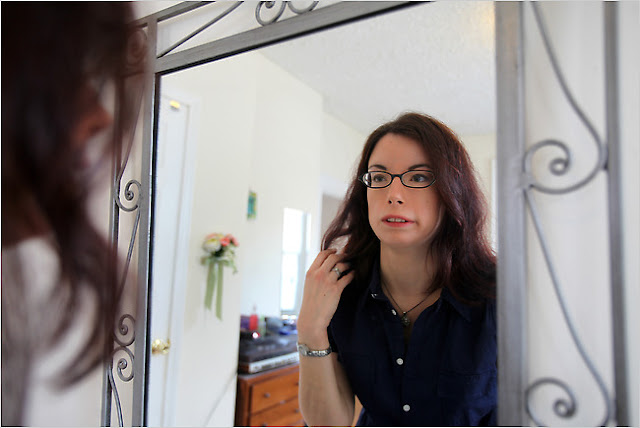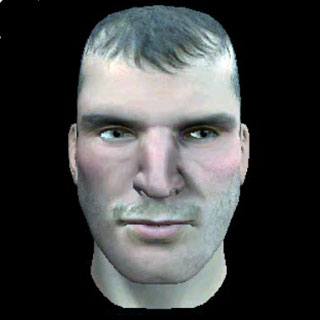NYT // April 5, 2010 // By BENEDICT CAREY
STUDYING EXPRESSIONS Kathleen Bogart, with her husband, Beau, at Tufts University, where she is a graduate student. Ms. Bogart has Moebius syndrome, which causes facial paralysis.
Like many of the Hurricane Katrinarefugees who straggled into Baton Rouge, La., in the summer of 2005, she needed more than food and shelter. She needed company, sympathy — someone, anyone, to see and feel her loss — and searched the face of her assigned social worker in vain.
But the social worker, barely out of college, seemed somehow emotionally removed. Something was missing.
“I could see the breakdown in the emotional connection between us, could see it happening and there was nothing I could do,” said Kathleen Bogart, 28, the social worker who is now a psychology researcher at Tufts University here. Ms. Bogart has Moebius syndrome, a rare congenital condition named for a 19th-century neurologist that causes facial paralysis.
When the people she helped made a sad expression, she continued, “I wasn’t able to return it. I tried to do so with words and tone of voice, but it was no use. Stripped of the facial expression, the emotion just dies there, unshared. It just dies.”
Researchers have long known that facial expressions are crucial to social interaction and have categorized them in great detail. They know which expressions are universal; they can distinguish slight differences in expression, for example between a polite smile and a genuine one.
Still, a central question remains: How does the brain interpret others’ expressions so quickly and accurately? The answer is likely to be enormously important, experts say, both for understanding how social interactions can go smoothly and how they can go off track.
Studies so far point to what psychologists call facial mimicry. During a social exchange, people subconsciously mirror each other’s surprise, disgust or delight — and, in effect, interpret the emotion by sensing what’s embodied on their own face. Interfere with the ability to mimic, these studies suggest, and people are less adept at reading others’ expressions.
But what if a person cannot mimic any expressions, at all?
In a new study, the largest to date of Moebius syndrome, Ms. Bogart and David Matsumoto, a psychologist at San Francisco State, found that people with the disorder, whatever their social struggles, had no trouble at all recognizing others’ expressions. They do just as well as anyone else in identifying emotions in photographed faces, despite having no way to mimic.
The findings strongly suggest that the brain has other systems to recognize facial expressions, and that people with facial paralysis learn to take advantage of those. “It seems likely they would develop compensatory strategies in response to the long-term impairment,” said Tanya Chartrand, a psychologist at Duke University who is not involved in the Moebius Syndrome study, in an e-mail message. “Ones that don’t rely on the mimicry process and allow them to understand emotion through a different route.”
If such strategies are teachable, experts say, they could help others with social awkwardness, whether because of anxiety, developmental problems like autism, or common causes of partial paralysis, like Bell’s palsy.
“I had no special interest in studying facial paralysis, even though I had it; there were many other things I could have done,” Ms. Bogart said, in her office at Tufts. “But in college I looked to see what psychologists had to say about it, and there was nothing. Very, very little on facial paralysis at all. And I was just — well, I was angry.”
The emotion tightened her fist, straightened her frame and ran up into her eyes, bypassing her face: “Angry. I thought, I might as well do it because certainly no one else is.”
Moebius syndrome has no known cause; it strikes less than one in 100,000 children at birth, resulting in total, or nearly total, facial paralysis. In most cases the eyes don’t blink, and the irises move only up and down, robbing people of sideways glances and an entire vocabulary of gazes, squints and eye-rolls. The taunts tend to start early in childhood and pile up, and no one can see the embarrassment or pain in the target. “Like having a deformity and not being able to communicate, all in one,” Ms. Bogart said.
Most people with the condition adapt. “Just like for blind people, whose senses of touch, smell, hearing become sharper,” Dr. Matsumoto said. “Same thing here, I think, only it’s in the domain of nonverbal communication.”
In the first of two studies, Ms. Bogart and Dr. Matsumoto had 36 people with Moebius syndrome look at 42 standardized photographs online of expressions, like anger, happiness and sadness. The participants correctly identified the emotions about three-quarters of the time — the same rate as adults without the condition. Their level of impairment was not related to their score.
The results do not imply that socializing is easy or natural for people with such paralysis; most do struggle, Ms. Bogart and Dr. Matusmoto found in a follow-up study. The main reason for this (beyond the immobile features, which distract some people) has little to do with a deficit in recognizing emotions in others, the studies suggest.
It most likely comes back to mimicry, or the lack thereof. In a series of studies, psychologists have found that social bonding between conversation partners is highly dependent on a rhythmic and usually subconscious give and take of gestures and expressions that creates a kind of shared good will. “Part of that could be the buying in on the interaction itself,” Dr. Chartrand said.
If the timing is not just right — the Moebius study did not account for timing — then the buy-in can feel uncertain, and interaction fizzles. The way that many people with complete, or near complete, paralysis overcome this problem is by relying on channels other than the face: eye contact, hand gestures, posture and voice tone. Many people with paralysis can make that expressive instrument as subtle and potent as a string section.
“I found my voice, figuratively and literally, in speech therapy,” said Matthew S. Joffe, the director of student services at LaGuardia Community College and a therapist in private practice, who has Moebius syndrome. Dr. Joffe described his paralysis as pronounced, “with a mouth that hangs open, and a lower lip that protrudes downward.”
“I use humor a lot,” he said. “It’s a way of showing my humanity, for one thing, and over the years people have said I have a great laugh. And I’m old enough now — I can agree. I laugh from the innards of my belly, I have many different laughs for different occasions, each one looks distinct in my body. I learned pretty early on that, given the fairly harsh standards society imposes, that if I didn’t laugh at stuff I would probably just collapse.”
Ms. Bogart, too, has a distinctive laugh. Her jaw drops,, her lips stretch and lift slightly, and her entire torso shakes. The need to rely on these peripheral channels makes people with paralysis especially sensitive to such cues in others. “At a party, I feel like I can tell whether someone will be worth talking to within seconds,” she said. “I can read people’s comfort level, or whether they can work through discomfort, very quickly.”
Taken together, some psychologists say, the evidence from people with paralysis and those without it suggests that the brain is tuning into several channels at once when it reads others’ emotional vibes. Mimicry is surely one — but it needs help.
In an experiment published last year, Dutch researchers had 46 students at Leiden University pair off for a three-minute interaction with a fellow student who was either lying or telling the truth about a donation to charity. Those students told not to mimic the expressions of their conversation partner were significantly better at determining who was telling the truth than students told to mimic, or given no instructions. “Mimicry, whether spontaneous or the product of instruction, hinders observers in objectively assessing” people’s true feelings.
The gestures and tones that people with paralysis are so adept at using add more information. “And we think there may be other systems as well, in pre-motor areas of the brain, that are compiling all of this information” so that the cortex can make a judgment on the emotion, Dr. Matsumoto said.
In her current research project, Ms. Bogart is videotaping dozens of social interactions with people with all variety of paralysis, not just Moebius, but Bell’s palsy, which often stills half the face, and nerve injuries.
“The plan is to show the interviews to people to see what their impressions are, to tease apart all the elements of face, voice, gestures to see what is perceived by people as positive or negative,” she said. “The idea is that if we could learn what the best nonverbal communication techniques are, we could teach those to people who are socially awkward for any reason.”
Source:
http://www.nytimes.com/2010/04/06/health/06mind.html?pagewanted=2&_r=2


























